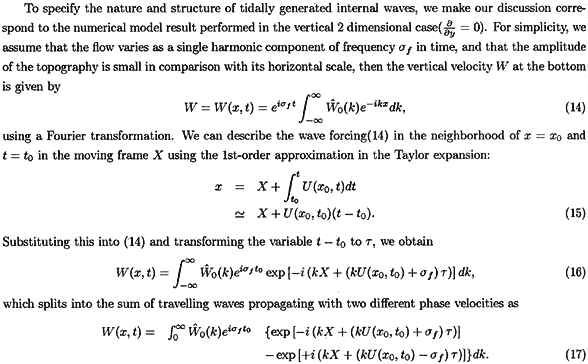Most of previous theories of internal waves generated by an oscillating tidal flow have neglected the advection effect in wave-excitation. However, (13) shows that at regions where the tidal flow is strong and the horizontal scale of forcing is small, such as sill-tops or shelf breaks, wave excitation cannot be comprehended unless the advection effect in wave-excitation is incorporated. In fact, steady lee waves, which have quite different properties from internal tides, are generated from the advection effect as investigated particularly by atmospheric physicists (e.g., Long 1953). However, the detailed dynamics of internal waves in the presence of both effects is still poor. For this investigation, a description in the moving frame is appropriate to reveal the physics of internal-wave excitation. Thus, hereafter frequency, phase velocity, and group velocity denote those in the moving frame.

This expression shows that internal waves excited in the neighborhood of x = x0 and t = t0 by the basic flow (U, W) is a sum of monochromatic waves with frequency of -kU(x0, t0)±σf and horizontal wavenumber of k. Their vertical wavenumber m is determined so as to satisfy the governing equations and the condition that their energy propagates upward. The internal wave field generated by a tidal flow over topography is formed by the superposition of these monochromatic waves excited at various times and positions and propagate upward.
Their frequencies consist of the term kU(x0, t0) which arises from the spatial variation of forcing and expresses, so called, lee waves, and of terms ±σf which stem from the time variation of the tidal flow and represent the so called internal tides. Therefore, according to the nondimensional parameter kU0/σf, we can classify internal waves excited by an oscillating flow into unsteady lee waves(when kU0/σf≫1) and “mixed tidal lee waves” (when kU0/σf 〜 1), in addition to internal tides(when kU0/σf≪1) which previous theoretical models have considered. This nondimensional parameter is a ratio of the effect of spatial to temporal forcing variations, or can be also interpreted as the ratio of tidal excursion U0/σf to the horizontal scale of vertical velocity k-1 that corresponds to the radius of curvature of the topography.